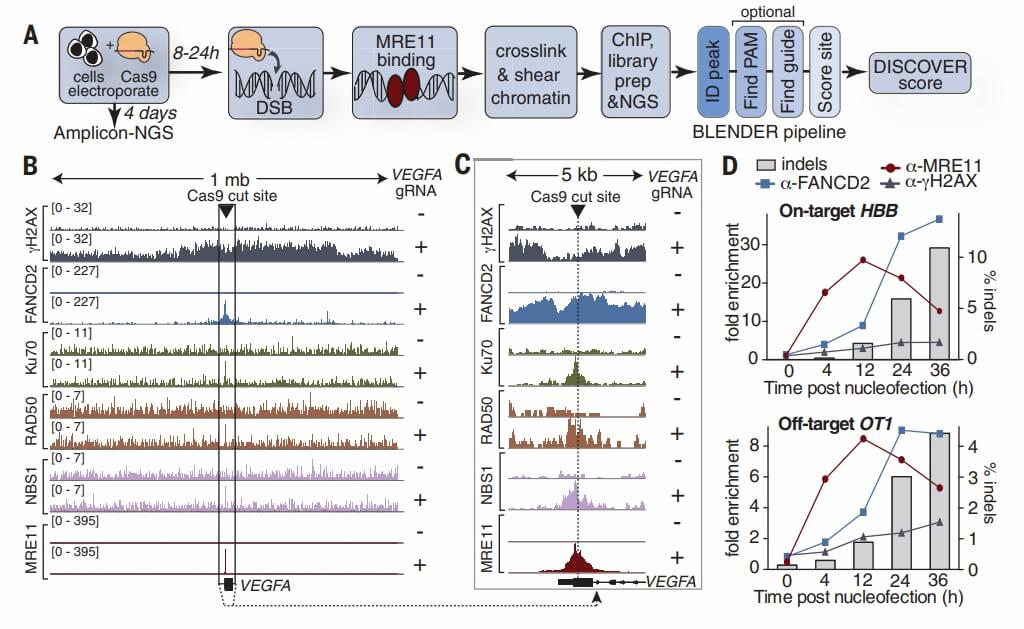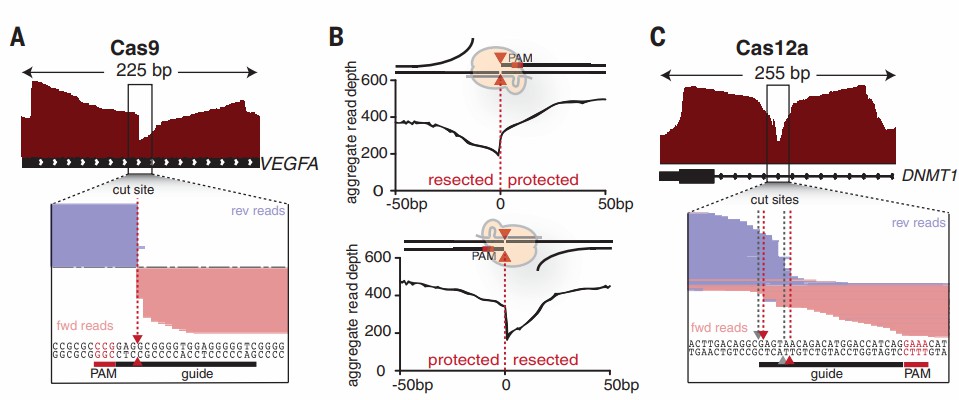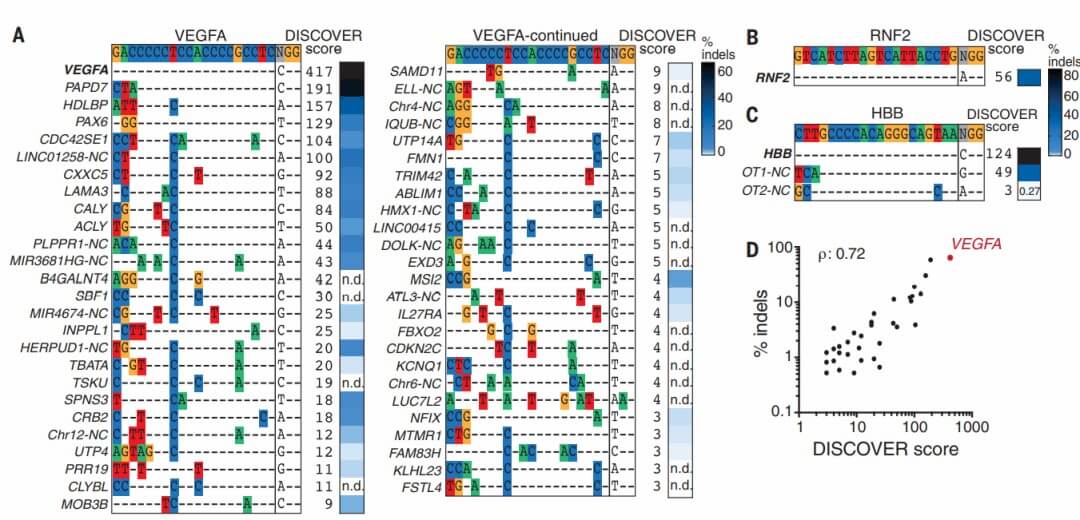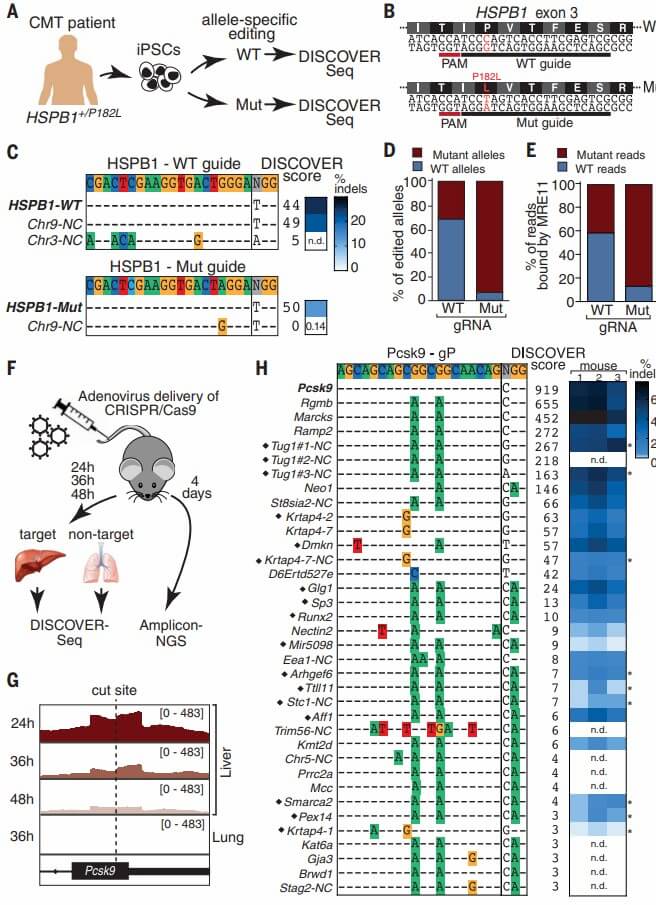We use cookies to understand how you use our site and to improve the overall user experience. This includes personalizing content and advertising. Read our Privacy Policy

In April 2019, Science published a seminal article titled "Unbiased Detection of CRISPR Off-Targets In Vivo Using DISCOVER-Seq." CRISPR-Cas-mediated genome editing induces targeted DNA damage, yet it may also cause unintended damage at off-target sites. Current methodologies for identifying off-target sites predominantly rely on purified DNA or specific cellular models, which preclude in vivo detection. To address this limitation, the research team developed the Detection of In Situ Cas Off-Targets and Verification by Sequencing (DISCOVER-Seq), an unbiased approach that leverages the recruitment of DNA repair factors within living cells and organisms to identify off-target activity.
By precisely tracking the recruitment of MRE11, a key DNA repair protein, DISCOVER-Seq achieves single-nucleotide precision in identifying the molecular characteristics of Cas activity within cells. This method is applicable across a broad range of single-guide RNA (sgRNA) and Cas enzyme systems, extending its utility to novel genome editing tools. Moreover, DISCOVER-Seq has been demonstrated to be effective in various models, including cell lines, patient-derived induced pluripotent stem cells (iPSCs), and adenovirus-edited mice. This innovation paves the way for in situ detection of off-target effects in individual patients during therapeutic genome editing, facilitating the identification of genotype-specific off-targets in clinical settings.
CRISPR-Cas genome editing technology holds substantial promise for therapeutic applications; however, accurately characterizing Cas-induced on-target and off-target DNA double-strand breaks (DSBs) remains challenging. Although methods for identifying off-target sites exist for in vitro and cellular models, these approaches have inherent limitations, such as high false-positive rates and the inability to perform in vivo assessments. In this context, the researchers have developed a universal method named DISCOVER-Seq, which facilitates unbiased identification of off-target sites and Cas molecular activity features in primary cells and in vivo tissues.
Genome editing relies on the repair of Cas-induced DSBs. The researchers hypothesized that monitoring this repair process could track genome editing and detect off-target effects. Cas9, which lacks catalytic activity, binds to sequences more frequently than it cleaves them. Consequently, chromatin immunoprecipitation sequencing (ChIP-Seq) targeting Cas9 itself may generate false positives. Conversely, capturing sequences bound by endogenous DNA repair proteins enables specific identification of Cas9-induced damage sites.
The researchers employed ChIP-Seq to investigate a panel of DNA repair proteins to ascertain their recognition capabilities for spCas9 target sites. They subsequently focused on the MRE11 subunit of the MRN complex, which is broadly expressed across various cell types and exhibits a close association with Cas9 cleavage sites. A commercially available specific antibody, cross-reactive with MRE11 proteins in both mice and humans, demonstrates potential for preclinical and clinical off-target detection without altering the workflow. MRE11 binding peaks are detectable prior to the emergence of insertions and deletions (indels) mutations and are readily identifiable at gRNA off-target sites. Most MRE11 ChIP-Seq reads precisely terminate at predicted Cas9 cleavage sites, enabling single-nucleotide resolution of nuclease sites.
Through extensive on-target and off-target assessments, the researchers identified an asymmetric distribution of Cas9 binding sites, correlating with the release of sgRNA following Cas9 cleavage. DISCOVER-Seq also revealed a tendency of Cas9 to produce one-base overhangs. MRE11 was also stably recruited to Cpf1 editing sites; however, the reads were overlapping and symmetrically distributed along the cleavage points, consistent with the mechanism of Cpf1. Consequently, MRE11 ChIP-Seq effectively captures the activity of various genome editing enzymes at the molecular level. The integration of MRE11 ChIP-Seq with the custom software BLENDER within the DISCOVER-Seq workflow enables in vivo detection of Cas9 off-targets.
Initially, the researchers evaluated the performance of DISCOVER-Seq for unbiased off-target detection using two well-characterized sgRNAs: "VEGFA_site2" targeting human K562 cells and "Pcsk9-gP" targeting mouse B16-F10 cells. DISCOVER-Seq identified 57 off-target sites for VEGFA_site2 and 45 off-target sites for Pcsk9-gP. Subsequent validation through amplicon-based next-generation sequencing (amplicon-NGS) revealed that all off-target sites identified and tested by DISCOVER-Seq exhibited higher indel rates compared to background levels.
Further testing involved sgRNAs RNF2 and Pcsk9-gM, which were devoid of off-target sites, as well as a HBB-targeting guide with two known off-target sites. DISCOVER-Seq accurately identified the target sites of these sgRNAs without generating false positives. It was observed that the inclusion of a guanine at the 5' end of the sgRNA insertion sequence reduced off-target effects, though this effect was variable.
Regarding enzyme specificity, DISCOVER-Seq indicated that the high-fidelity (HiFi) Cas9 mutant exhibited reduced off-target activity. The scoring provided by DISCOVER-Seq showed a high correlation with the final indel frequencies across various contexts. Comparison of DISCOVER-Seq using VEGFA_site2 sgRNA in K562 cells demonstrated significant overlap in identified sites, alongside unique sites detected by each method. Based on empirical data, the sensitivity threshold for DISCOVER-Seq was determined to be 0.3% indel.
In summary, DISCOVER-Seq performed effectively in unbiased and quantitative off-target identification for various Cas nucleases and sgRNAs.
 Figure 1. ChIP of DNA repair proteins at Cas-induced DSBs
Figure 1. ChIP of DNA repair proteins at Cas-induced DSBs
Traditional off-target detection methods often exhibit limitations when applied to iPSCs and other primary cells due to reagent toxicity. The ability of DISCOVER-Seq to identify patient-specific off-target sites in iPSCs was evaluated. Utilizing high-fidelity Cas9, the researchers edited both wild-type (WT) and mutant (Mut) alleles of the HSPB1 gene in iPSCs derived from a patient with Charcot-Marie-Tooth disease (CMT). This process required the development of customized editing strategies to knockout the mutant allele while preserving the wild-type allele.
DISCOVER-Seq identified one on-target site and two off-target sites for the wild-type allele of HSPB1, with one off-target site located in a repetitive region on chromosome 9. However, no off-target sites were detected for the mutant allele. Allelic dropout analysis from amplicon-based next-generation sequencing revealed that the wild-type sgRNA edited approximately 30% of the mutant alleles, whereas the sgRNA targeting the mutant allele edited about 7% of the wild-type alleles.
The sequence data derived from DISCOVER-Seq provided allele-specific summaries for sgRNAs targeting the mutant alleles, demonstrating that DISCOVER-Seq can be effectively employed for preclinical off-target detection in patient-derived primary cells. Additionally, it holds potential for allele-specific identification.
 Figure 2. MRE11 ChIP molecularly characterizes Cas-induced DSBs
Figure 2. MRE11 ChIP molecularly characterizes Cas-induced DSBs
The identification of off-target effects during in vivo genome editing poses a significant challenge to the clinical translation of CRISPR-Cas systems. DISCOVER-Seq, which relies on endogenous DNA repair factors, theoretically facilitates the identification of off-target effects during in vivo editing. To evaluate this capability, researchers employed a mixture of Pcsk9-gP gRNAs in murine models. The system was meticulously studied using VIVO, a method capable of detecting off-target sites within purified DNA, and these potential off-target sites were subsequently validated using amplicon-NGS.
In this study, adenoviral vectors were used to deliver Pcsk9-gP gRNA and Cas9 or Cas9 alone to the mice. Indels were observed four days post-injection, prompting the researchers to perform DISCOVER-Seq at 24, 26, and 48 hours post-injection, followed by amplicon-NGS analysis at the four-day mark. The DISCOVER scores for the target sites in hepatic tissues peaked at 24 hours and decreased over time, with no detectable signal in the lungs, an off-target organ.
To mitigate minor variations among individual animals, a pooling method was applied. DISCOVER-Seq identified 36 off-target sites, 27 of which were selected for indel validation. The indel rates for the 27 tested sites ranged from 0.9% to 78.1%. Although DISCOVER-Seq in vivo failed to detect the extremely low-frequency off-targets identified by VIVO, 17 off-targets validated by NGS were recognized as suboptimal by VIVO due to their absence in nearly 3,000 VIVO hits and false positives.
 Figure 3. Unbiased off-target discovery using DISCOVER-seq
Figure 3. Unbiased off-target discovery using DISCOVER-seq
 Figure 4. DISCOVER-seq in patient-derived iPSCs and in vivo
Figure 4. DISCOVER-seq in patient-derived iPSCs and in vivo
CD Genomics is dedicated to advancing research through comprehensive CRISPR/Cas9 off-target detection and analysis services.
Take the Next Step: Explore Related Services
Learn More
Comprehensive Methods for Off-Target Detection in Gene Editing
DISCOVER-seq represents a universal, unbiased method for detecting off-target effects in genome editing, elucidating the molecular mechanisms and dynamics of Cas nucleases in both cellular and animal models. By enabling the quantitative analysis of DSBs, DISCOVER-seq provides insights into the events occurring prior to the manifestation of genome editing outcomes. This capability is crucial for identifying cleavage sites that may lead to challenging-to-detect results, such as translocations and large deletions.
While in vitro off-target assays are highly sensitive, they are prone to generating extensive false-positive results. Additionally, genomic DNA lacks other conditions, such as chromatin state and modifications, that influence Cas9 activity. In contrast, DISCOVER-seq enables in situ detection of off-target effects in a single step. The broad conservation of MRE11 binding across species indicates that DISCOVER-seq has substantial potential for application beyond murine models.
The efficacy of DISCOVER-seq in vivo and in patient-derived iPSCs underscores its potential for clinical therapeutic applications. This includes the identification of individual genotypes relevant to specific tissue types and the real-time detection of editing outcomes in patient biopsy samples during clinical in vivo editing.
Reference

CD Genomics is transforming biomedical potential into precision insights through seamless sequencing and advanced bioinformatics.
We use cookies to understand how you use our site and to improve the overall user experience. This includes personalizing content and advertising. Read our Privacy Policy